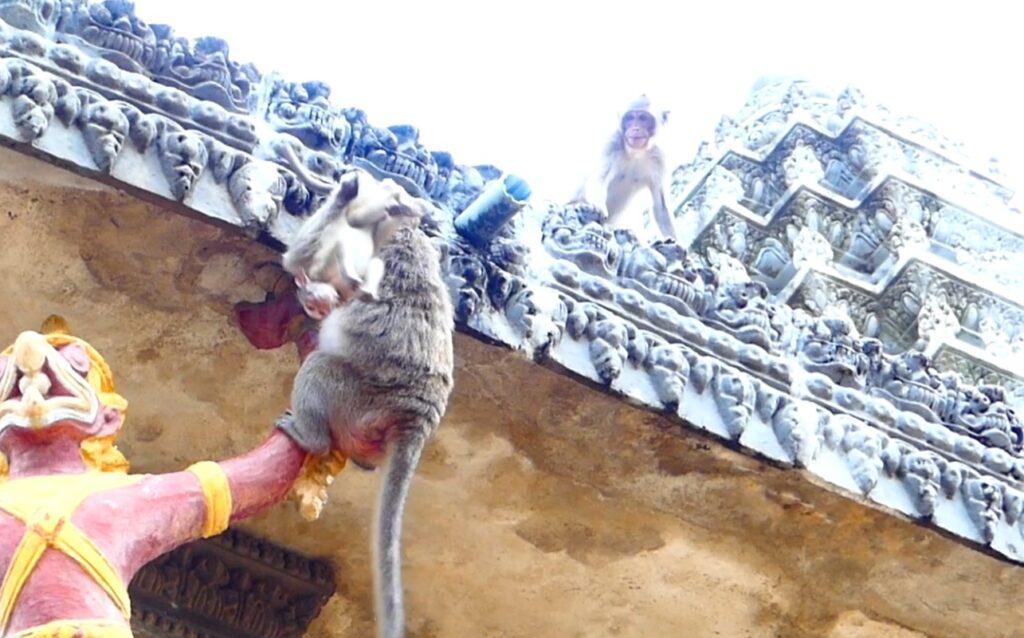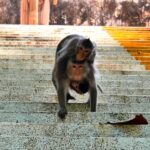In a heartbreaking display of the dangers that urban expansion and human infrastructure pose to wildlife, a baby monkey recently suffered a severe electric shock after coming into contact with a power line. The tragic incident, captured on camera by bystanders, showed the tiny primate in visible distress, struggling to cling to its mother as it fought the effects of the electric shock.
The Incident The young monkey was navigating its usual environment when it inadvertently grasped a live electrical wire. The high-voltage shock sent the animal into immediate convulsions before it fell back onto the ground, dazed and weakened. The mother monkey, displaying deep maternal instincts, rushed to its side, attempting to comfort and encourage her baby to move. Witnesses reported that the mother cradled the injured infant, urging it to climb onto her back as it normally would. However, the baby’s muscles appeared stiff, and its grip was noticeably weak, likely due to nerve damage caused by the electrical shock.
Passersby and local animal rescue workers were deeply moved by the mother’s unwavering attempts to help her baby recover. Some concerned individuals attempted to intervene, but the protective mother kept them at a distance, as monkeys in distress can often become defensive and aggressive.
The Dangers of Power Lines for Wildlife This tragic event highlights a growing issue in regions where urban expansion encroaches upon natural habitats. Power lines pose a significant risk to tree-dwelling animals, particularly primates, birds, and squirrels. In many areas, monkeys use electrical cables as an alternative to trees, unaware of the dangers these wires present.
Electrocution is a leading cause of injury and death among urban-dwelling primates. Wildlife conservationists have long called for protective measures, such as insulating power lines, rerouting them underground where possible, or providing alternative structures like rope bridges to allow safe movement for animals. Unfortunately, in many developing regions, such precautions are either insufficient or entirely absent due to financial and logistical constraints.
The Aftermath and Conservation Efforts Reports indicate that local wildlife rescuers eventually managed to retrieve the baby monkey and provide it with emergency care. However, the extent of its injuries remained uncertain. Electrocuted animals often suffer from burns, neurological damage, and internal injuries that can lead to long-term complications or even death.
In response to this incident, animal welfare organizations have renewed their calls for better infrastructure planning to ensure wildlife safety. Education campaigns have also been encouraged to raise awareness among communities living in close proximity to wildlife, urging residents to report hazardous power lines and support conservation-friendly development projects.
A Mother’s Unbreakable Bond One of the most poignant aspects of this tragedy was the mother monkey’s determination to care for her suffering baby. Primates share a strong emotional connection with their offspring, and this incident was a raw display of a mother’s love and grief. Witnesses described how she repeatedly tried to groom and carry the baby, seemingly hoping that the comfort of her presence would ease its pain.
This heartbreaking scene is a stark reminder of the consequences of human development encroaching upon wildlife territories. As deforestation and urbanization continue, countless animals are forced to navigate unfamiliar and dangerous environments, often with devastating outcomes.
Looking Forward To prevent such tragedies from recurring, conservationists are advocating for the implementation of wildlife-friendly electrical infrastructure. Some measures include insulating power lines, constructing artificial canopy bridges, and increasing green spaces to reduce reliance on power cables as travel routes. Additionally, local authorities and utility companies must collaborate with environmental experts to ensure that development does not come at the cost of vulnerable wildlife populations.

Ultimately, while human progress and urbanization are inevitable, it is our responsibility to minimize harm to the creatures who share our planet. The heartbreaking struggle of this baby monkey and its devoted mother should serve as a call to action, reminding us of the urgent need to balance modernization with compassion for the natural world.
